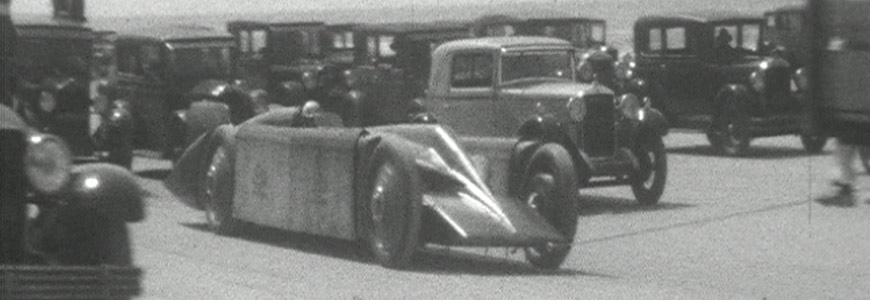
The National Motor Museum Trust has released unique archive footage from Henry Segrave’s personal films to mark the 90th anniversary of ‘Golden Arrow’ breaking the Land Speed Record.
It’s 1929 and excited crowds have gathered on Daytona Beach to watch Major Henry Segrave prepare to break the Land Speed Record in the Irving-Napier Special ‘Golden Arrow’. Segrave’s team are getting ready for a trial run, but photographers and cameramen hamper their efforts, clamouring for extra shots. At one point the run is even disrupted by overzealous spectators who break through the police cordon and spill onto the sands… But all of this is forgotten as the day of the record attempt arrives and Golden Arrow thunders down the sands, achieving a new Land Speed Record of 231.446mph.
These are the remarkable scenes depicted in archive footage released by National Motor Museum Trust to mark the 90th anniversary of Segrave’s achievement. Taken from a set of Segrave home movies, the footage is a fantastic insight into the exhilarating (and slightly chaotic) world of Land Speed Record attempts.
A shorter video focuses on Segrave’s two record-breaking runs on Daytona Beach on 11 March 1929. His wife Doris, Captain Jack Irving – the designer of the Golden Arrow – and Ray Keech, whose record he had just broken, are there to congratulate him at the timing centre.
A longer version of the video adds extra detail to the record-breaking story, covering the team’s arrival on the SS Majestic in New York in February 1929 and showing footage from the trial runs – including the disruption caused by those overzealous spectators. The film also reveals that the team didn’t travel light – along with the Golden Arrow, there were six mechanics, 21 cases of spares, 500 gallons of petrol, 200 gallons of oil and two touring cars.
Golden Arrow 1929 – Short Version
Golden Arrow 1929 – Long version
Golden Arrow can be seen on display alongside other record-breaking vehicles in For Britain & For The Hell Of It in the National Motor Museum. This inspiring multimedia display celebrates the success of British record-breakers and also features the Sunbeam 350hp, Sunbeam 1000hp and Bluebird CN7.
Entry to For Britain & For The Hell Of It is included in your general admission ticket to Beaulieu, which also includes entry to the National Motor Museum, World of Top Gear, Palace House and Beaulieu Abbey. Find out more about ticket prices or plan your visit.
A short history: Segrave & the Golden Arrow Land Speed Record
During the 1920s and 1930s, the Land Speed Record was contested regularly. Successful British racing driver Major Henry Segrave had been the first man to exceed 200mph on land, taking the 1,000hp Sunbeam to a record speed of 203.792mph at Daytona in 1927. Malcolm Campbell raised the record to 206.956mph in February 1928 only to have America’s Ray Keech in the Triplex Special exceed this by a little over 0.5mph a month later! Segrave was determined to retake the record for Britain.
Golden Arrow was shipped to Daytona in February 1929 where Segrave made two 180mph test runs. A two week wait for a suitable period of good weather followed before he was able to make his attempt on 11 March 1929. Huge crowds gathered on Daytona Beach to watch Segrave make his two timed runs through the measured mile; 15.55 seconds on the first run, 15.57 on the second. The speed of 231.446mph exceeded Keech’s record by 24mph.
For more information about the Golden Arrow and Segrave’s record attempts, please visit the National Motor Museum Trust website.
